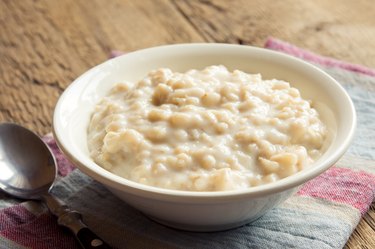
If you have a chronic digestive disorder like gastroparesis, you might experience nausea, vomiting, bloating and a feeling of fullness shortly after consuming only a small amount of food. That's because your digestive system isn't working properly. To help relieve the symptoms, your doctor may place you on a special diet, often called a motility diet, that's focused on increasing your digestive system motility. Seek medical help if you have symptoms that persist even after you've adhered to the diet or had treatment.
Basic Guidelines
Video of the Day
While you're on a motility diet, you'll need to eat approximately four to six meals spaced throughout the day. Each will most likely be smaller than you're used to eating. You will also need to lower your intake of fat and fiber, both of which increase the amount of time it takes for food to leave your stomach. Chew each bite thoroughly, drink plenty of fluid while eating and try to take a walk immediately after each meal to encourage the digestive process.
Video of the Day
Foods to Avoid and Include
Good food choices for a motility diet include well-cooked fruits and vegetables -- peeled, if necessary -- products like bread or pasta made from refined grains like white flour; liquids such as juice or milk; and cooked meat, seafood or poultry that's been ground or pureed. Steer clear of any whole grains, nuts, seeds, beans, legumes and high-fiber produce, such as Brussels sprouts, berries, apples, oranges, green beans, peas and leafy greens. Potatoes are fine as long as they are peeled first.
Sample Daily Menu
A typical day on a motility diet might begin with a scrambled egg, cream of wheat prepared with nonfat milk and grape juice for breakfast. Lunch could be a turkey sandwich on white bread, vegetable soup, applesauce and milk, while baked chicken or fish, mashed potatoes, cooked spinach, milk and fruit cocktail could serve as dinner. Midorning, afternoon and bedtime snacks could be a fruit smoothie, pudding, gelatin or instant oatmeal made with nonfat milk.
Additional Considerations
If you have a chronic medical problem, don't attempt to design a motility diet on your own. Get nutrition advice from a dietitian to ensure that you're getting enough of the nutrients your body needs, says the American Neurogastroenterology and Motility Society. You may need to begin taking dietary supplements if you're not able to meet your nutritional requirements with the diet alone. Individuals whose symptoms aren't alleviated by the basic motility plan may need to move to a version of the diet that includes only liquids and thinned, pureed foods.